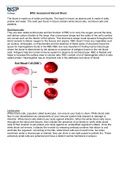Essay
Unit 20 BIOMEDICAL SCIENCE
- Module
- Unit 20 - Biomedical Science
- Institution
- PEARSON (PEARSON)
A very good assignment and very detailed. I got a DISTINCTION. About 20 hours of work without any copy paste from internet everything in my own words.
[Show more]



